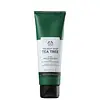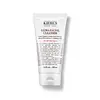What's inside
What's inside
 Key Ingredients
Key Ingredients

 Benefits
Benefits

 Concerns
Concerns

 Ingredients Side-by-side
Ingredients Side-by-side

Water
Skin ConditioningKaolin
AbrasiveGlycerin
HumectantPropanediol
SolventMagnesium Aluminum Silicate
AbsorbentPerlite
AbsorbentXanthan Gum
EmulsifyingCocamidopropyl Betaine
CleansingSodium Laureth Sulfate
CleansingDecyl Glucoside
CleansingPEG-7 Glyceryl Cocoate
EmulsifyingAlcohol Denat.
AntimicrobialPhenoxyethanol
PreservativeHydrogenated Jojoba Wax
Melaleuca Alternifolia Leaf Oil
AntioxidantSodium Chloride
MaskingCitric Acid
BufferingSalicylic Acid
MaskingCalophyllum Inophyllum Seed Oil
AntimicrobialMenthol
MaskingEthylhexylglycerin
Skin ConditioningTrisodium Ethylenediamine Disuccinate
Sodium Benzoate
MaskingTetrasodium Pyrophosphate
BufferingLeptospermum Petersonii Oil
MaskingCitral
PerfumingPhosphoric Acid
BufferingTocopherol
AntioxidantCI 77891
Cosmetic ColorantCI 77499
Cosmetic ColorantWater, Kaolin, Glycerin, Propanediol, Magnesium Aluminum Silicate, Perlite, Xanthan Gum, Cocamidopropyl Betaine, Sodium Laureth Sulfate, Decyl Glucoside, PEG-7 Glyceryl Cocoate, Alcohol Denat., Phenoxyethanol, Hydrogenated Jojoba Wax, Melaleuca Alternifolia Leaf Oil, Sodium Chloride, Citric Acid, Salicylic Acid, Calophyllum Inophyllum Seed Oil, Menthol, Ethylhexylglycerin, Trisodium Ethylenediamine Disuccinate, Sodium Benzoate, Tetrasodium Pyrophosphate, Leptospermum Petersonii Oil, Citral, Phosphoric Acid, Tocopherol, CI 77891, CI 77499
Water
Skin ConditioningSodium Laureth Sulfate
CleansingDecyl Glucoside
CleansingGlycerin
HumectantCocamidopropyl Betaine
CleansingDisodium Cocoamphodiacetate
CleansingAcrylates Copolymer
Lauryl Glucoside
CleansingPEG-200 Hydrogenated Glyceryl Palmate
CleansingTriethanolamine
BufferingSodium Chloride
MaskingPentylene Glycol
Skin ConditioningPhenoxyethanol
PreservativePEG-7 Glyceryl Cocoate
EmulsifyingSodium Hydroxide
BufferingCitric Acid
BufferingHexylene Glycol
EmulsifyingBehenyl Alcohol
EmollientDistearyl Ether
Skin ConditioningSodium Benzoate
MaskingLaureth-2
CleansingSqualane
EmollientPrunus Amygdalus Dulcis Oil
Skin ConditioningPrunus Armeniaca Kernel Oil
MaskingTocopherol
AntioxidantAscorbyl Glucoside
AntioxidantPersea Gratissima Oil
Skin ConditioningWater, Sodium Laureth Sulfate, Decyl Glucoside, Glycerin, Cocamidopropyl Betaine, Disodium Cocoamphodiacetate, Acrylates Copolymer, Lauryl Glucoside, PEG-200 Hydrogenated Glyceryl Palmate, Triethanolamine, Sodium Chloride, Pentylene Glycol, Phenoxyethanol, PEG-7 Glyceryl Cocoate, Sodium Hydroxide, Citric Acid, Hexylene Glycol, Behenyl Alcohol, Distearyl Ether, Sodium Benzoate, Laureth-2, Squalane, Prunus Amygdalus Dulcis Oil, Prunus Armeniaca Kernel Oil, Tocopherol, Ascorbyl Glucoside, Persea Gratissima Oil
 Reviews
Reviews

Ingredients Explained
These ingredients are found in both products.
Ingredients higher up in an ingredient list are typically present in a larger amount.
Citric Acid is an alpha hydroxy acid (AHA) naturally found in citrus fruits like oranges, lemons, and limes.
Like other AHAs, citric acid can exfoliate skin by breaking down the bonds that hold dead skin cells together. This helps reveal smoother and brighter skin underneath.
However, this exfoliating effect only happens at high concentrations (20%) which can be hard to find in cosmetic products.
Due to this, citric acid is usually included in small amounts as a pH adjuster. This helps keep products slightly more acidic and compatible with skin's natural pH.
In skincare formulas, citric acid can:
While it can provide some skin benefits, research shows lactic acid and glycolic acid are generally more effective and less irritating exfoliants.
Most citric acid used in skincare today is made by fermenting sugars (usually from molasses). This synthetic version is identical to the natural citrus form but easier to stabilize and use in formulations.
Read more about some other popular AHA's here:
Learn more about Citric AcidCocamidopropyl Betaine is a fatty acid created by mixing similar compounds in coconut oil and dimethylaminopropylamine, a compound with two amino groups.
This ingredient is a surfactant and cleanser. It helps gather the dirt, pollutants, and other impurities in your skin to be washed away. It also helps thicken a product and make the texture more creamy.
Being created from coconut oil means Cocamidopropyl Betaine is hydrating for the skin.
While Cocamidopropyl Betaine was believed to be an allergen, a study from 2012 disproved this. It found two compounds in unpure Cocamidopropyl Betaine to be the irritants: aminoamide and 3-dimethylaminopropylamine. High-grade and pure Cocamidopropyl Betaine did not induce allergic reactions during this study.
Learn more about Cocamidopropyl BetaineDecyl Glucoside is a glucose-based surfactant and emulsion stabilizer. It is created by reacting glucose with the fatty acids from plants.
Surfactants help clean the skin by trapping oil, sebum, and dirt to be washed away. As an emulsion stabilizer, it stabilizes the ingredients in a product by preventing them from separating.
This ingredient is biodegradable and non-toxic. This ingredient is commonly found in baby shampoos.
Decyl Glucoside is sometimes used to stabilize the UV filter Tinosorb.
Learn more about Decyl GlucosideGlycerin is already naturally found in your skin. It helps moisturize and protect your skin.
A study from 2016 found glycerin to be more effective as a humectant than AHAs and hyaluronic acid.
As a humectant, it helps the skin stay hydrated by pulling moisture to your skin. The low molecular weight of glycerin allows it to pull moisture into the deeper layers of your skin.
Hydrated skin improves your skin barrier; Your skin barrier helps protect against irritants and bacteria.
Glycerin has also been found to have antimicrobial and antiviral properties. Due to these properties, glycerin is often used in wound and burn treatments.
In cosmetics, glycerin is usually derived from plants such as soybean or palm. However, it can also be sourced from animals, such as tallow or animal fat.
This ingredient is organic, colorless, odorless, and non-toxic.
Glycerin is the name for this ingredient in American English. British English uses Glycerol/Glycerine.
Learn more about GlycerinPeg-7 Glyceryl Cocoate is created from polyethylene glycol and fatty acids from coconut oil.
It is a synthetic polymer with emulsifying and cleansing properties.
As an emulsifier, Peg-7 Glyceryl Cocoate prevents ingredients such as oils and water from separating. It also helps rinse away oils, dirt, and pollutants from skin.
Peg-7 Glyceryl Cocoate may not be fungal acne safe. It can also dry out skin.
Learn more about PEG-7 Glyceryl CocoatePhenoxyethanol is a preservative that has germicide, antimicrobial, and aromatic properties. Studies show that phenoxyethanol can prevent microbial growth. By itself, it has a scent that is similar to that of a rose.
It's often used in formulations along with Caprylyl Glycol to preserve the shelf life of products.
Sodium Benzoate is a preservative. It's used in both cosmetic and food products to inhibit the growth of mold and bacteria. It is typically produced synthetically.
Both the US FDA and EU Health Committee have approved the use of sodium benzoate. In the US, levels of 0.1% (of the total product) are allowed.
Sodium benzoate works as a preservative by inhibiting the growth of bacteria inside of cells. It prevents the cell from fermenting a type of sugar using an enzyme called phosphofructokinase.
It is the salt of benzoic acid. Foods containing sodium benzoate include soda, salad dressings, condiments, fruit juices, wines, and snack foods.
Studies for using ascorbic acid and sodium benzoate in cosmetics are lacking, especially in skincare routines with multiple steps.
We always recommend speaking with a professional, such as a dermatologist, if you have any concerns.
Learn more about Sodium BenzoateChances are, you eat sodium chloride every day. Sodium Chloride is also known as table salt.
This ingredient has many purposes in skincare: thickener, emulsifier, and exfoliator.
You'll most likely find this ingredient in cleansers where it is used to create a gel-like texture. As an emulsifier, it also prevents ingredients from separating.
There is much debate on whether this ingredient is comedogenic. The short answer - comedogenic ratings don't tell the whole story. Learn more about comegodenic ratings here.
The concensus about this ingredient causing acne seems to be divided. Research is needed to understand if this ingredient does cause acne.
Scrubs may use salt as the primary exfoliating ingredient.
Learn more about Sodium ChlorideSodium Laureth Sulfate (SLES) is a foaming, cleansing, and emulsifying ingredient. It is created from palm kernel oil or coconut oil. SLES is not the same as sodium lauryl sulfate. It is much milder and less likely to irritate.
SLES helps create foam in personal products. It also prevents ingredients from separating, helping to elongate the shelf life.
Sodium Laureth Sulfate is a type of sulfate. It can be drying. We recommend speaking with a professional about using this ingredient if you have concerns.
Learn more about Sodium Laureth SulfateTocopherol (also known as Vitamin E) is a common antioxidant used to help protect the skin from free-radicals and strengthen the skin barrier. It's also fat soluble - this means our skin is great at absorbing it.
Vitamin E also helps keep your natural skin lipids healthy. Your lipid skin barrier naturally consists of lipids, ceramides, and fatty acids. Vitamin E offers extra protection for your skin’s lipid barrier, keeping your skin healthy and nourished.
Another benefit is a bit of UV protection. Vitamin E helps reduce the damage caused by UVB rays. (It should not replace your sunscreen). Combining it with Vitamin C can decrease sunburned cells and hyperpigmentation after UV exposure.
You might have noticed Vitamin E + C often paired together. This is because it is great at stabilizing Vitamin C. Using the two together helps increase the effectiveness of both ingredients.
There are often claims that Vitamin E can reduce/prevent scarring, but these claims haven't been confirmed by scientific research.
Learn more about TocopherolWater. It's the most common cosmetic ingredient of all. You'll usually see it at the top of ingredient lists, meaning that it makes up the largest part of the product.
So why is it so popular? Water most often acts as a solvent - this means that it helps dissolve other ingredients into the formulation.
You'll also recognize water as that liquid we all need to stay alive. If you see this, drink a glass of water. Stay hydrated!
Learn more about Water